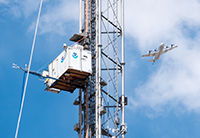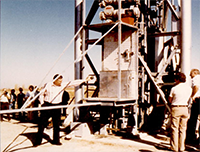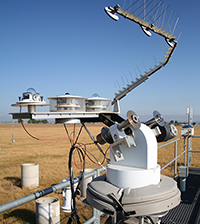Sunset for the NOAA BAO
After nearly 40 years of observations, experiments, and instrument testing, the Boulder Atmospheric Observatory closes
Amid wheat fields and natural grasslands approximately 25 miles east of the Rocky Mountains, the Boulder Atmospheric Observatory (BAO) in Erie, Colorado has been a unique location for studying the planetary boundary layer and for testing and calibrating atmospheric sensors. Operated for almost 40 years by what is now the NOAA Earth System Research Laboratories’s Physical Sciences Laboratory, and host to numerous field programs, the BAO’s legacy recently came to an end.
Initially called the NOAA/NCAR/CIRES Joint Meteorological Observatory, the BAO sat on 100 acres of land leased by NOAA from the Colorado State Land Board. The centerpiece of the facility, a 985-foot tower, was constructed in 1977 at a cost of approximately $1.5M. In October of that year, NOAA began outfitting the site.
“In the very beginning, there was a big first experiment planned requiring that the tower be ready by the fall of 1978,” said meteorologist Dan Wolfe, who has worked at the BAO as both a NOAA, and a CIRES employee over the lifetime of the site. Wolfe and three engineers spent all winter wiring and mounting instruments to the tower, often wearing snowmobile suits to keep warm. “I was very young, and it was pretty exciting working outdoors, doing something very few people get to do, ” said Wolfe. The crew finished on time, and the very first experiment at the site, Project Phoenix, kicked off as planned in September 1978.
The tower’s original instrumentation and data acquisition system came from Air Force Cambridge Research Laboratories, in Massachusetts, and was originally set up to support atmospheric boundary layer probes that measured temperature, humidity, wind, and turbulence. Later, instruments measuring solar and infrared radiation, and greenhouse gases were added.
The BAO has also served as a validation site for a wide variety of radar, lidar, sodar, infrasonic, remote sensing systems, and aircraft-, balloon-, and satellite-borne sensors. It has been part of several studies looking into the structure of passing cold fronts, convergence lines, wind shear, gust fronts, and mountain waves. It has also been the centerpiece of a number of air quality studies. Measurements taken at the tower have been used to validate satellite retrievals and global climate models, in addition to serving as a long-term local and regional climate record.
Although there have been many interesting and important studies, there are a couple things that stick out in Wolfe’s memory. “When the infrasound array was still active, we captured the eruption of Mount St. Helens in May of 1980,” said Wolfe. They were testing instruments at the site that capture infrasonic sound (sound below the range of human hearing). It was theorized that these low-frequency sounds are produced by a variety of geophysical processes and might provide advanced warning and monitoring of extreme events.
The tower was also used as part of the Denver Brown Cloud Studies, which took place in the mid 1980s. It was the first major multi-agency study to look at air quality in Colorado’s Front Range. Measurements were taken at the BAO of aerosols and the meteorology influencing Denver’s air quality and provided to the Colorado Department of Health. “It was exciting working on a project so relevant to the community in which we lived,” said Wolfe. “It led to not only understanding, but improving Denver's and the region's air quality.”
The Colorado State Land Board (CSLB) leased the BAO property to NOAA. When the lease expired in 1999, the CSLB generously granted NOAA a holdover lease through 2016. Over the past couple of years, the two agencies discussed renewal of the site’s lease. The CSLB is mandated to use its properties to generate revenue for statewide education resources, and ultimately decided to reclaim the property for its original development purposes. In addition, the BAO property is not quite as remote as it used to be – residential and commercial development has gotten closer – and use of the facility has also declined somewhat in recent years. In the end, it seemed to be a mutually beneficial time to discontinue operations. Although the CSLB offered additional time to vacate, NOAA decided to decommission the tower and related equipment this year.

The BAO’s legacy has ended as it should, with two monumental field campaigns: Deriving Information on Surface Conditions from COlumn and VERtically Resolved Observations Relevant to Air-Quality (DISCOVER-AQ), in the summer of 2014, and the Experimental Measurement Campaign for Planetary Boundary Layer Instrument Assessment (XPIA) study in 2015.
The site officially shut down at the end of July—all the instruments have been removed and the building adjacent to the tower has been demolished. It remains to be seen what will be done with the tower and one remaining building. Wolfe, there at the beginning and now at the end, organized a closing celebration, which was held at the site on Thursday, November 3, 2016.
“In the beginning, it was all about the excitement of doing something so unique,” said Wolfe. “Now it is more about the science and working with so many special people. This feeling will continue even though the exhilaration of working high above the ground has ended.”
For more information about the BAO, visit: http://psl.noaa.gov/technology/bao/
Posted: November 3, 2016 | Updated: November 4, 2016



